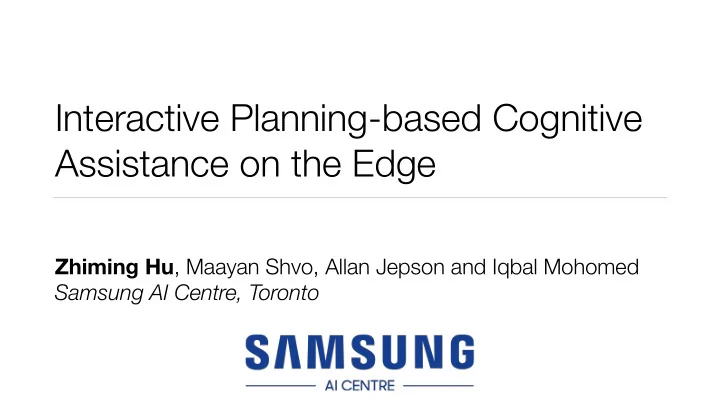

Interactive Planning-based Cognitive Assistance on the Edge Zhiming Hu , Maayan Shvo, Allan Jepson and Iqbal Mohomed Samsung AI Centre, Toronto
What is cognitive assistance? ‣ One of the most exciting applications in AR Glasses ‣ Google Glass, HoloLens 2 ‣ Helpful in a myriad of tasks ‣ Health care education and training ‣ Industrial tool for remote support ‣ Cooking assistant and fitness coach Image source for HoloLens 2: https://commons.wikimedia.org/wiki/File:HoloLens_2.jpeg, https://creativecommons.org/licenses/by/2.0/legalcode, changes are not made on the image. � 2
How to build a cognitive assistant? ‣ Lots of existing work on building cognitive assistance [1,2,3,4] ‣ Perception module ‣ Determine the current task state ‣ Cognitive module ‣ Generate the next step [1] VideoPipe: Building Video Stream Processing Pipelines at the Edge, Middleware 2019 [2] https://github.com/cmusatyalab/gabriel-sandwich [3] Mohan, S., Ramea, K., Price, B., Shreve, M., Eldardiry, H., & Nelson, L. (2019). Building Jarvis-A Learner-Aware Conversational Trainer. In IUI Workshops. [4] Laird, John E. The Soar cognitive architecture. MIT press, 2012. � 3
The motivation ‣ While it is simple to build a state machine to guide a user to complete some tasks, there are several issues ‣ The state machine needs to be pre-defined ‣ It cannot list all the possible user errors, thus cannot recover from such failure cases. Bread ? Bread Ham Lettuce Tomato Bread � 4
How about a planner? ‣ Benefits ‣ Flexible, can recover from any user errors ‣ Challenges ‣ Need to calculate accurate current task state (CTS) ‣ Not as computationally efficient as state machines. � 5
Classifier for the Top Object on the Sandwich Sequence of Classification Results: Bread -> Ham -> Bread Stack Bread on Ham OR Unstack Ham from Bread A planning problem ‣ A planning problem may be encoded in PDDL by defining the domain, initial state, and goal state. • stack(x,y) 2 A – Pre stack = { clear(x),clear(y),ontable(x) } – eff + stack = { on(x,y) } (note: x is on y ) – eff � stack = { clear(y) } • G = { onTable (bread1), on (ham,bread1), on (lettuce,ham), \ on (bread2,lettuce), on (tomato,bread2), on (bread3,tomato)} ‣ If all of the ingredients are clear and on the table , one possible solution is π = stack(ham,bread1),stack(lettuce,ham),stack(bread2,lettuce), stack(tomato,bread2),stack(bread3,tomato) . The key to get the correct plan is to obtain accurate current task state � 6
Ambiguity Resolving ‣ We keep track of the current task state by recognizing the actions taken since the beginning of the interaction. ‣ However, we may encounter ambiguous cases where we cannot determine which action was performed by the user. Classifier for the Top Object on the Sandwich Sequence of Classification Results: Bread -> Ham -> Bread Stack Bread on Ham OR Unstack Ham from Bread � 7
Dynamic State Tracking ‣ A planner with state machines ‣ The planner will only be called when an unexpected action is detected Start Unstack Tomato from Ham Stack Ham on Bread Stack Lettuce Observed Activity on Ham Replanning Stack Lettuce Stack Tomato on Ham on Ham Stack Bread on Lettuce Stack Bread on Lettuce End End Figure 3: State tracking with a planner and state machines. The green box shows the current expected action. � 8
Start Unstack Tomato from Ham Stack Ham on Bread Stack Lettuce Observed Activity on Ham Replanning Stack Lettuce Stack Tomato on Ham on Ham Stack Bread on Lettuce Stack Bread on Lettuce End End Runtime of the planner and classifier 1.00 1.00 0.75 0.75 CD) CD) 0.50 0.50 0.25 0.25 0.00 0.00 0.2 0.3 0.4 0.02 0.03 5untime fRr the plDnner (s) 5untime fRr the FlDssifier (s) (a) Runtime for the planner. (b) Runtime for the classifier Figure 4: Runtime for the planner and the classifier. It is feasible to run both the planner and classifier on the edge. � 9
Demo ‣ The video for our demo is available here. � 10
Future Work ‣ Personalized instructions ‣ Resource management for multiple cognitive assistance agents ‣ Applications that only need partial order ‣ Linear Temporal Logic (LTL) � 11
Summary ‣ We have proposed an architecture for cognitive assistants on the edge ‣ Ambiguous task states are prevalent and we need to deal with them ‣ We should combine the planner with state machines to enjoy both of the benefits. � 12
Thanks! zhiming.hu@samsung.com � 13
Recommend
More recommend